Top 10 Scenic Nature Trails In North Brabant
Introduction to North Brabant’s Scenic Nature Trails North Brabant’s scenic nature trails showcase diverse landscapes. Explore the Loonse and Drunense Dunes, Europe’s largest sand drift area, or visit the Biesbosch National Park, a maze of rivers and wetlands full of wildlife. The Groote Peel offers peaceful marshlands, while the Kampina is known for its colorful … Read more
